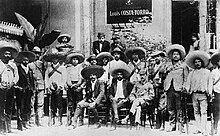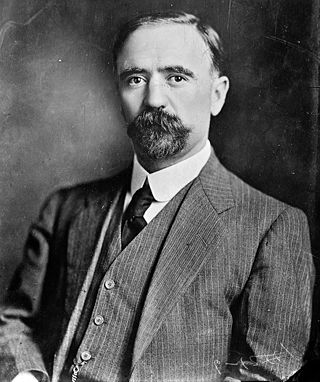
Francisco I. Madero González was a Mexican businessman, revolutionary, writer and statesman, who served as the 37th president of Mexico from 1911 until he was deposed in a coup d'état in February 1913 and assassinated. He came to prominence as an advocate for democracy and as an opponent of President and de facto dictator Porfirio Díaz. After Díaz claimed to have won the fraudulent election of 1910 despite promising a return to democracy, Madero started the Mexican Revolution to oust Díaz. The Mexican revolution would continue until 1920, well after Madero and Díaz's deaths, with hundreds of thousands dead.
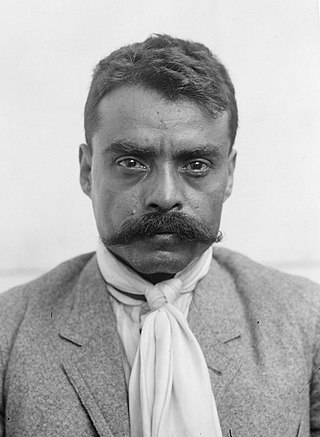
Emiliano Zapata Salazar was a Mexican revolutionary. He was a leading figure in the Mexican Revolution of 1910–1920, the main leader of the people's revolution in the Mexican state of Morelos, and the inspiration of the agrarian movement called Zapatismo.
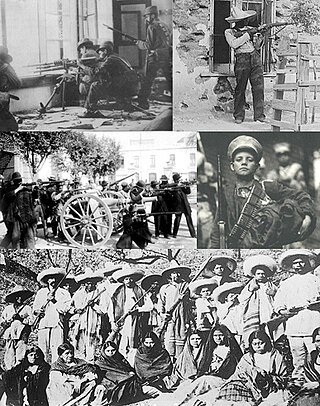
The Mexican Revolution was an extended sequence of armed regional conflicts in Mexico from 20 November 1910 to 1 December 1920. It has been called "the defining event of modern Mexican history" and resulted in the destruction of the Federal Army, its replacement by a revolutionary army, and the transformation of Mexican culture and government. The northern Constitutionalist faction prevailed on the battlefield and drafted the present-day Constitution of Mexico, which aimed to create a strong central government. Revolutionary generals held power from 1920 to 1940. The revolutionary conflict was primarily a civil war, but foreign powers, having important economic and strategic interests in Mexico, figured in the outcome of Mexico's power struggles; the U.S. involvement was particularly high. The conflict led to the deaths of around one million people, mostly noncombatants.
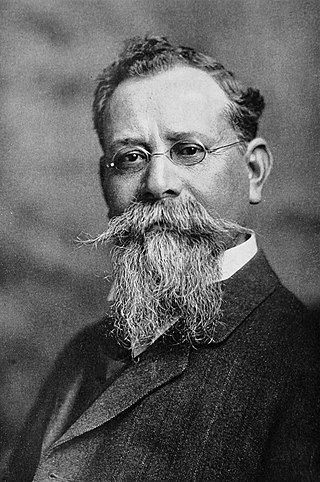
José Venustiano Carranza de la Garza was a Mexican land owner and politician who served as President of Mexico from 1917 until his assassination in 1920, during the Mexican Revolution. He was previously Mexico's de facto head of state as Primer Jefe of the Constitutionalist faction from 1914 to 1917, and previously served as a senator and governor for Coahuila. He played the leading role in drafting the Constitution of 1917 and maintained Mexican neutrality in World War I.

The Plan of Ayala was a document drafted by revolutionary leader Emiliano Zapata during the Mexican Revolution. In it, Zapata denounced President Francisco Madero for his perceived betrayal of the revolutionary ideals embodied in Madero's Plan de San Luis Potosí, and set out his vision of land reform. The Plan was first proclaimed on November 28, 1911, in the town of Ayala, Morelos, and was later amended on June 19, 1914. The Plan of Ayala was a key document during the revolution and influenced land reform in Mexico during the 1920s and 1930s. It was the fundamental text of the Zapatistas.

The Liberation Army of the South was a guerrilla force led for most of its existence by Emiliano Zapata that took part in the Mexican Revolution from 1911 to 1920. During that time, the Zapatistas fought against the national governments of Porfirio Díaz, Francisco Madero, Victoriano Huerta, and Venustiano Carranza. Their goal was rural land reform, specifically reclaiming communal lands stolen by hacendados in the period before the revolution. Although rarely active outside their base in Morelos, they allied with Pancho Villa to support the Conventionists against the Carrancistas. After Villa's defeat, the Zapatistas remained in open rebellion. It was only after Zapata's 1919 assassination and the overthrow of the Carranza government that Zapata's successor, Gildardo Magaña, negotiated peace with President Álvaro Obregón.

Genovevo de la O was an important figure in the Mexican Revolution in Morelos.

In the history of Mexico, the Plan of Guadalupe was a political manifesto which was proclaimed on March 26, 1913, by the Governor of Coahuila Venustiano Carranza in response to the reactionary coup d'etat and execution of President Francisco I. Madero, which had occurred during the Ten Tragic Days of February 1913. The manifesto was released from the Hacienda De Guadalupe, which is where the Plan derives its name, nearly a month after the assassination of Madero. The initial plan was limited in scope, denouncing Victoriano Huerta's usurpation of power and advocating the restoration of a constitutional government. In 1914, Carranza issued "Additions to the Plan of Guadalupe", which broadened its scope and "endowed la Revolución with its social and economic content." In 1916, he further revised the Plan now that the Constitutionalist Army was victorious and revolutionaries sought changes to the 1857 Constitution of Mexico. Carranza sought to set the terms of the constitutional convention.
In Mexican history, a plan was a declaration of principles announced in conjunction with a rebellion, usually armed, against the central government of the country. Mexican plans were often more formal than the pronunciamientos that were their equivalent elsewhere in Spanish America and Spain. Some were as detailed as the United States Declaration of Independence. Some plans simply announced that the current government was null and void and that the signer of the plan was the new president.

The Constitutionalists were a faction in the Mexican Revolution (1910–1920). They were formed in 1914 as a response to the assassination of Francisco Madero and Victoriano Huerta's coup d'etat. Also known as Carrancistas, taking that name from their leader, Venustiano Carranza the governor Coahuila. The Constitutionalists played the leading role in defeating the Mexican Federal Army on the battlefield. Carranza, a centrist liberal attracted Mexicans across various political ideologies to the Constitutionalist cause. Constitutionalists consisted of mainly middle-class urbanites, liberals, and intellectuals who desired a democratic constitution under the guidelines "Mexico for Mexicans" and Mexican nationalism. Their support for democracy in Mexico, caught the attention of the United States who aided their cause. In 1914, the United States occupied Mexico's largest port in Veracruz in an attempt to starve Huerta's government of customs revenue. They crafted and enforced the Mexican Constitution of 1917 which remains in force today. Following the defeat of General Huerta, the Constitutionalists outmaneuvered their former revolutionary allies Emiliano Zapata and Pancho Villa becoming the victorious faction of the Mexican Revolution. However the Constitutionalists were divided amongst themselves and Carranza was assassinated in 1920. He was succeeded by General Álvaro Obregón who began enforcing the 1917 constitution and calming revolutionary tensions. His assassination and the subsequent power vacuum this created spurred his successor, Plutarco Elías Calles to create the National Revolutionary Party (PNR) which would hold uninterrupted political power in Mexico until 2000.
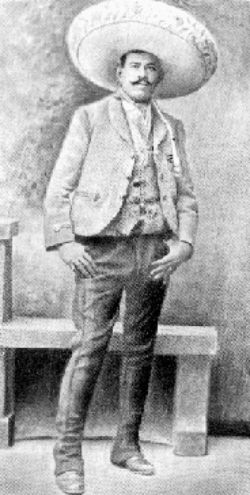
Amador Salazar Jiménez was a Mexican military leader who participated in the Mexican Revolution.

The Treaty of Ciudad Juárez was a peace treaty signed between the President of Mexico, Porfirio Díaz, and the revolutionary Francisco Madero on May 21, 1911. The treaty put an end to the fighting between forces supporting Madero and those of Díaz and thus concluded the initial phase of the Mexican Revolution.

The Battle of Cuautla was a battle between the forces of Emiliano Zapata and the federal army of the Mexican government that took place in the state of Morelos from May 11–19, 1911, during the Mexican Revolution. It has sometimes been described as "six of the most terrible days of battle in the whole Revolution". Eventually, the remains of the defending "Golden Fifth" regiment, the Fifth Cavalry Regiment of the Federal Army, withdrew and Zapata took control of the town. The Zapatista victory convinced Porfirio Díaz to come to terms with Francisco Madero, agree to the Treaty of Ciudad Juárez and resign as president.

Otilio Edmundo Montaño Sánchez was a Zapatista general during the Mexican Revolution.

Pablo González Garza was a general during the Mexican Revolution. He is considered to be the main organizer of the assassination of Emiliano Zapata.

Jesús Salgado was a revolutionary leader and soldier in the Mexican Revolution, sometimes called the "Guerrero Zapata". He initially supported Francisco Madero but in 1911 threw his support behind Emiliano Zapata and remained loyal to the Zapatista cause until his death in 1919.

Antonio Diaz Soto y Gama was a Mexican politician and revolutionary during the Mexican Revolution.
The Morelos Commune is a name used by some historians to refer to the political and economic system established in the Mexican state of Morelos between 1913 and 1917. Led by Emiliano Zapata, the people of Morelos implemented a series of wide-reaching social reforms based on the proposals laid out in the Plan of Ayala.
The Battle of Parque was a battle during the Mexican Revolution, where Emiliano Zapata and his supporters rebelling against president Francisco I. Madero, who had recently overthrown the previous president Porfirio Díaz. A group of Zapata's supporters attempted to ambush a train containing 27 Mexican Rurales under the command of the American Soldier of Fortune, Emil Lewis Holmdahl.

